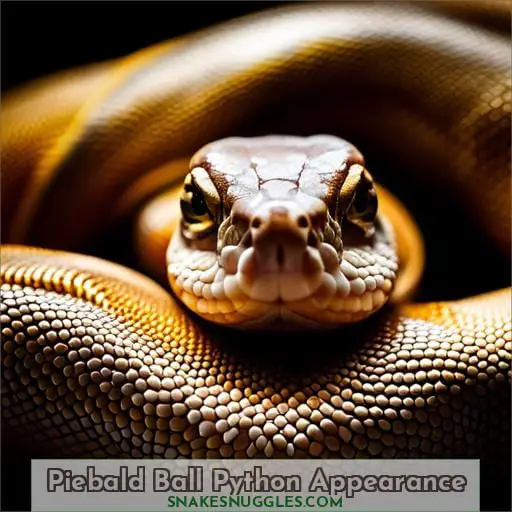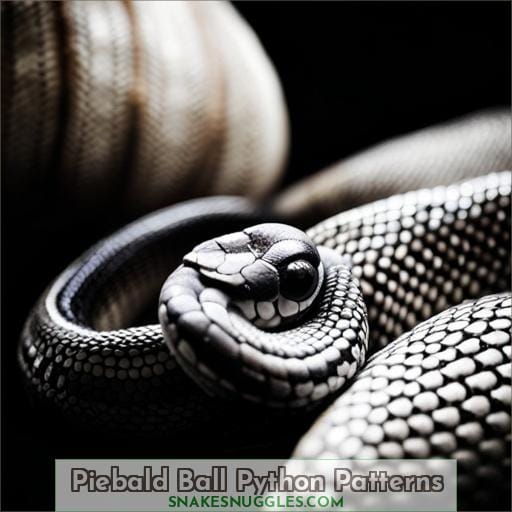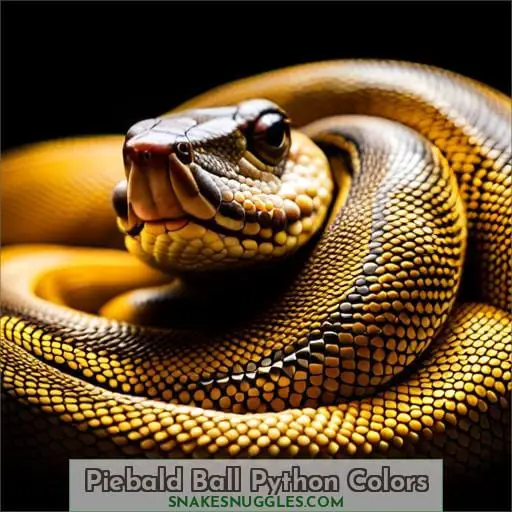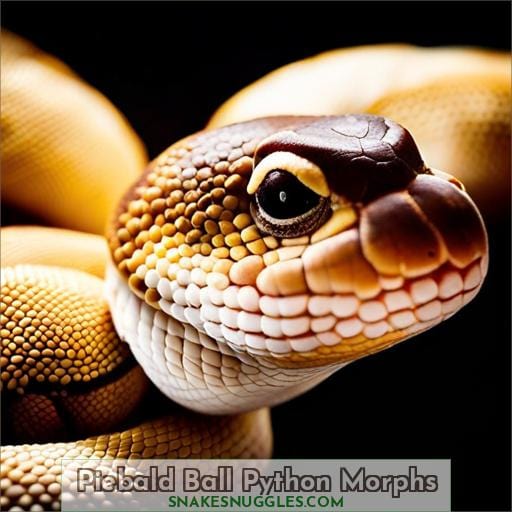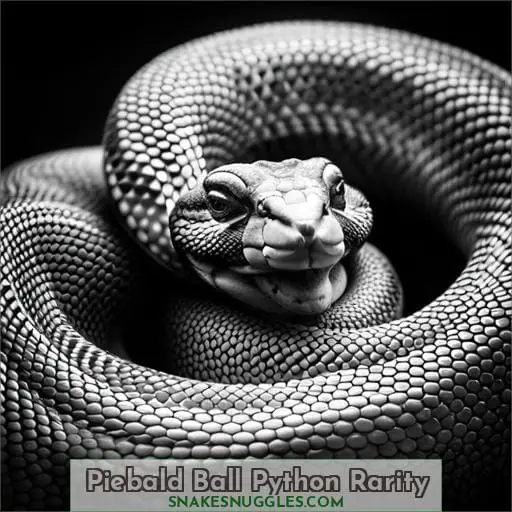This site is supported by our readers. We may earn a commission, at no cost to you, if you purchase through links.

Delve into the scientific realm of piebald ball python genetics and uncover the intricate interplay of genes that orchestrates this snake’s unique appearance.
Discover the patterns that dance across its scales, the colors that paint its vibrant tapestry, and the genetic factors that determine its elusive rarity.
Prepare to embark on a journey into the fascinating world of piebald ball python genetics, where knowledge awaits those who seek it.
Table Of Contents
- Key Takeaways
- Piebald Ball Python Appearance
- Piebald Ball Python Genetics
- Piebald Ball Python Patterns
- Piebald Ball Python Colors
- Piebald Ball Python Morphs
- Piebald Ball Python Rarity
- Frequently Asked Questions (FAQs)
- What are the health risks associated with breeding Piebald Ball Pythons?
- How do Piebald Ball Pythons differ from other types of Ball Pythons in terms of their care and maintenance?
- What are the most common Piebald Ball Python morphs, and how do they differ in appearance?
- Are there any ethical considerations to keep in mind when breeding or purchasing Piebald Ball Pythons?
- What are the long-term costs associated with owning a Piebald Ball Python, including veterinary care, food, and supplies?
- Conclusion
Key Takeaways
- Piebald pattern caused by a genetic mutation that leads to white coloration and dark markings
- Involves interaction between a dominant gene for white scales and a recessive gene controlling markings
- Selective breeding produced Piebald Ball Python morphs ranging from high white to low white
- Combining piebald genes with other morphs leads to unique genetic combinations and appearances
Piebald Ball Python Appearance
Your Piebald Ball Python‘s head resembles a normal ball python, usually black or dark brown with stripes on both sides, normally just behind the nostrils. The pattern tends to start in a ‘Y’ shape at the top of the neck. Most have patterned heads, though some can be mostly white with just a slight smudge.
The body is one of the most recognizable in the reptile hobby, with a sharp contrast between the unrecognizable pattern and bright white scales. Piebalds tend to show most of the pattern higher up the body, with it decreasing towards the tail.
The relative availability of Piebalds isn’t specified.
Some Piebald lines have issues with small eyes, including Lesser Platinum Piebalds, Super Bamboo Piebalds, Super Daddy Gene Piebalds, Super Lesser Piebalds, and Super Mocha Piebalds.
Piebald Ball Python Genetics
You’ll find Piebald Ball Python genetics fascinating, uniquely giving it its characteristic patterns and colors.
Picture this: a striking contrast between bold black and white blotches adorning its body, like a captivating chessboard of nature.
Intriguingly, the amount of patterning can vary greatly, ranging from a predominantly white snake with scattered black markings to one cloaked in a mesmerizing display of black and white.
Unraveling the genetic secrets behind these variations is a captivating journey into the world of Piebald Ball Python genetics.
This morph owes its existence to a combination of dominant and recessive genes, with the dominant gene responsible for the white coloration and the recessive gene controlling the black markings.
Selective breeding practices have led to the development of various Piebald Ball Python morphs, each possessing distinct patterns and color combinations.
Piebald Ball Pythons inherit their docile temperament and calm demeanor from their genetic lineage, making them suitable companions for reptile enthusiasts seeking a gentle and captivating pet.
Piebald Ball Python Patterns
Inheriting a mixture of regular patterns and stark white scales, your Piebald Ball Python’s patterns are nothing short of striking.
The piebald pattern types range from a high white with minimal pattern to a low white with extensive patterning. The color variations in piebalds are equally diverse, encompassing shades of black, brown, yellow, and even lavender.
Mixing different piebald morphs can yield unique combinations of patterns and colors. For instance, combining the Piebald gene with the Pastel gene produces a Piebald Pastel Ball Python with intricate patterns and vibrant hues.
Other popular piebald morph combinations include the Piebald Spider, Piebald Mojave, and Piebald Clown.
The piebald pattern is caused by a mutation in the snake’s genes that disrupts the normal development of pigment cells. This mutation can affect the snake’s eyes as well, resulting in a variety of eye colors, including blue, red, and yellow.
Over time, the piebald pattern has evolved through selective breeding, leading to the development of new and exciting variations.
Piebald Ball Python Colors
Now, let’s delve into the captivating world of Piebald Ball Python colors. These snakes exhibit a mesmerizing array of hues and patterns, making each one a unique masterpiece. The color variations arise from intricate genetic interactions between different genes.
By combining various breeding combos, breeders have created Piebalds with breathtaking color palettes. From classic black and white to vibrant oranges and yellows, the possibilities are seemingly endless.
Each color variation possesses its own distinctive charm, captivating the hearts of reptile enthusiasts worldwide.
The genetic differences that give rise to these color variations are fascinating. Each gene plays a specific role in determining the snake’s appearance, influencing everything from the base color to the pattern combinations.
Understanding these genetic intricacies allows breeders to create Piebalds with specific color traits, producing snakes that are true works of art.
Piebald Ball Python Morphs
Your Piebald’s morph can vary from a high white, covering most of its body, to a low white, displaying more of its pattern.
This variation in the amount of white is due to the interaction of multiple genes, including the piebald gene and other modifier genes.
The albino piebald ball python is a popular morph that exhibits a white or cream body with black and white patches.
Double recessive piebald ball pythons are homozygous for the piebald gene, meaning they have two copies of the gene.
Piebald ball pythons can also carry co-dominant genes, such as the pastel gene. When a piebald ball python is bred to a snake carrying a co-dominant gene, the offspring can exhibit a combination of the piebald and co-dominant traits.
For instance, the super pastel piebald ball python is a striking morph that combines the high white of the piebald gene with the light colors and intricate patterns of the pastel gene.
Piebald Ball Python Rarity
Piebald Ball Python morphs, just like other ball python morphs, are available in a range of rarities.
Some Piebalds are more prevalent than others, with some being so rare that they command a high price tag.
Factors that influence rarity include the specific genetics of the morph, the demand for the morph among breeders and hobbyists, and the availability of breeding stock.
To ensure the well-being of these captivating creatures, it’s crucial to provide appropriate care, including a suitable habitat, a balanced diet, and regular veterinary checkups.
If you’re considering adding a Piebald Ball Python to your collection, research the genetics, care requirements, and breeding practices to make an informed decision.
By following best practices in snake breeding ethics and prioritizing animal welfare, such as those outlined in guidelines for ethical snake breeding, you can contribute to the preservation and responsible breeding of these remarkable snakes.
Frequently Asked Questions (FAQs)
What are the health risks associated with breeding Piebald Ball Pythons?
Breeding Piebald Ball Pythons carries the risk of genetic issues like small eyes.
This is particularly true for certain combinations, such as:
- Lesser Platinum
- Super Bamboo
- Super Mocha Piebalds
How do Piebald Ball Pythons differ from other types of Ball Pythons in terms of their care and maintenance?
Piebald Ball Pythons, like their counterparts, thrive in warm, humid environments with ample hiding spots and temperature gradients.
Their care and maintenance align with general Ball Python husbandry, emphasizing proper humidity, temperature regulation, and a diet of appropriately sized rodents.
What are the most common Piebald Ball Python morphs, and how do they differ in appearance?
Unravel the enigma of Piebald Ball Python morphs, each a symphony of patterns and hues.
From the classic elegance of the Lesser Platinum to the striking contrast of the Super Daddy Gene, explore their captivating diversity.
Lesser Platinum: A timeless classic, the Lesser Platinum Piebald Ball Python captivates with its subtle yet striking pattern. Its silvery-white scales, adorned with dark markings, create a mesmerizing tapestry that evokes the essence of moonlight on a tranquil lake.
Super Daddy Gene: A bold and audacious morph, the Super Daddy Gene Piebald Ball Python commands attention with its stark contrast. Its jet-black scales, juxtaposed against vibrant white patches, create a visually stunning display that resembles a celestial dance between light and darkness.
The Piebald Ball Python morphs are a testament to the boundless creativity of nature, offering a kaleidoscope of patterns and colors that never cease to amaze.
Are there any ethical considerations to keep in mind when breeding or purchasing Piebald Ball Pythons?
When considering breeding or purchasing Piebald Ball Pythons, reflect on the potential genetic issues associated with specific morphs, such as reduced eye size.
Prioritize the well-being of the animals by choosing pairings that minimize the risk of passing on these concerns.
What are the long-term costs associated with owning a Piebald Ball Python, including veterinary care, food, and supplies?
Owning a Piebald Ball Python entails understanding the factors affecting ball python prices, such as genetics and morphs, which can greatly impact the price of a ball python, and learning more about the ball python price range, long-term costs:
- Veterinary checkups
- Nutritious food
- Essential supplies:
- Enclosures
- Heating lamps
- Substrate
Budgeting for these expenses ensures your pet’s well-being.
Conclusion
As you delve deeper into the captivating world of piebald ball python genetics, you’ll uncover the intricate tapestry of genetic factors that orchestrate this snake’s mesmerizing appearance.
Through this exploration, you’ll gain a profound appreciation for the complexity and beauty of nature’s designs, leaving you in awe of the piebald ball python’s genetic legacy.

